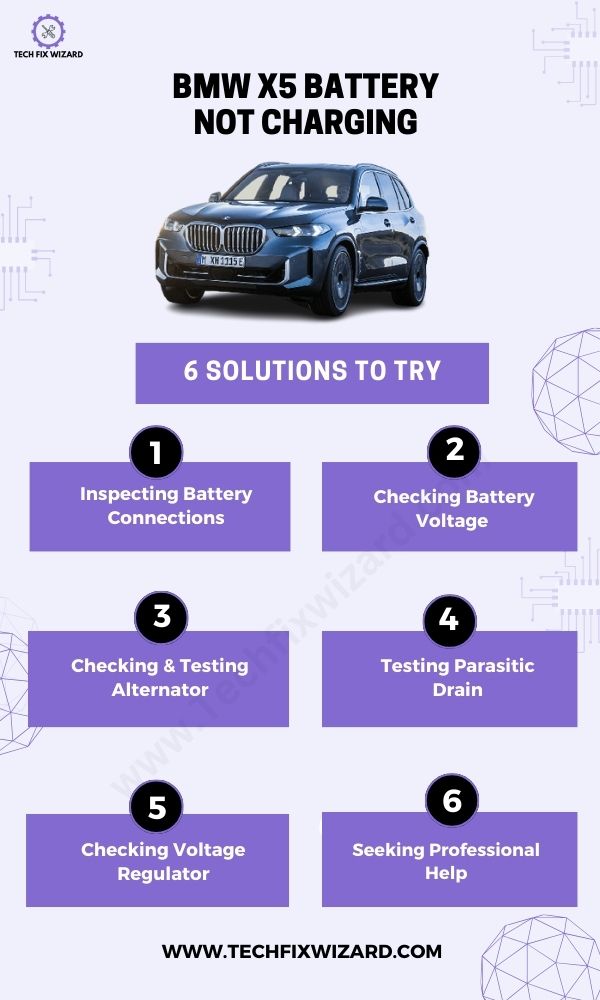A BMW X5 battery not charging is a common issue that many owners may encounter.
When the battery fails to charge properly, it can lead to significant inconveniences and potential breakdowns.
In this article, we will provide you with a step-by-step guide to resolve this issue so that you can enjoy your BMW X5 to its fullest potential.
Contents
- 1
- 2 BMW X5 Battery Not Charging – 8 Possible Causes
- 3 Troubleshooting Bmw X5 Battery Not Charging
- 4 1. Inspecting Battery Connections
- 5 2. Checking Battery Voltage
- 6 3. Checking & Testing Alternator Functionality
- 7 4. Testing Parasitic Drain
- 8 5. Checking Voltage Regulator
- 9 6. Seeking Professional Help if Needed
- 10 Preventing Battery Not Charging Issues in the Future
- 11 FAQs
- 12 Why is my BMW X5 battery not charging?
- 13 What should I do if my BMW X5 battery is not holding a charge?
- 14 Can a faulty alternator cause the BMW X5 battery not to charge?
- 15 What are the signs of a failing alternator in a BMW X5?
- 16 How can I check if my BMW X5 alternator is working?
- 17 Can a loose battery connection cause the BMW X5 battery not to charge?
- 18 Is it safe to jump-start my BMW X5 if the battery is not charging?
- 19 Can extreme temperatures affect the BMW X5 battery charging?
- 20 How often should I replace the battery in my BMW X5?
- 21 Official References & Resources
BMW X5 Battery Not Charging – 8 Possible Causes
Identifying the root cause is crucial to effectively troubleshoot and resolve the issue. Below, here is a list of potential causes to consider when diagnosing a BMW X5 battery not charging problem.
| No. | Possible Causes | Description |
|---|---|---|
| 1 | Faulty alternator | The alternator may not generate enough power or be completely malfunctioning, resulting in inadequate charging. |
| 2 | Battery-related issues | Battery age, deterioration, or loose/corroded connections can prevent proper charging. |
| 3 | Wiring and fuse problems | Faulty connections, damaged wiring, or blown fuses can interrupt the charging system. |
| 4 | Voltage regulator malfunction | A malfunctioning voltage regulator can lead to insufficient charging. |
| 5 | Battery temperature sensor failure | Failure of the battery temperature sensor can affect the charging system. |
| 6 | Excessive parasitic drain | Electrical components/systems drawing excessive power when the vehicle is off can drain the battery. |
| 7 | Defective charging system components | Components inside the alternator, such as diode trio, rectifier, or brushes, can fail, affecting charging. |
| 8 | Belt tension or wear | A loose or worn alternator belt can prevent proper alternator spinning, leading to inadequate charging. |
Troubleshooting Bmw X5 Battery Not Charging
Following is a step-by-step troubleshooting approach to help you diagnose and potentially fix the battery not charging problem in your BMW X5.
1. Inspecting Battery Connections
Starting the troubleshooting process by checking the battery connections is a prudent first step when dealing with a BMW X5 battery not charging issue.
As the electrical lifeline of the vehicle, the battery connections play a crucial role in ensuring a smooth charging process. Follow the steps below to check the battery connections.
- Locate the battery: The battery is typically found in the engine compartment. Refer to the owner’s manual if needed.
- Ensure safety precautions: Turn off the engine, remove the key from the ignition, and wear safety gloves and eye protection.
- Examine the battery terminals: Carefully inspect the terminals for looseness or corrosion.
- Check for loose connections: Gently try to move the battery terminals by hand to identify any movement.
- Tighten the connections: Use a wrench or socket set to securely tighten the battery terminal clamps.

You Might Also Like: BMW X5 Hybrid Not Charging – 5 Steps To Resolve It
2. Checking Battery Voltage
Now it’s time to check the battery voltage to determine if deteriorating battery health is the underlying cause of the issues you are experiencing with your BMW X5.
- Begin by turning off the engine and ensuring all electrical accessories are turned off.
- Open the hood of your BMW X5 and locate the battery in the engine compartment.
- Set your multimeter to the DC voltage setting, ensuring the range is suitable (0-20 volts).
- Identify the battery terminals – positive terminal marked with a “+” symbol, negative with a “-” symbol.
- Connect the multimeter leads red lead to the positive terminal and black lead to the negative terminal.
- Read the voltage displayed on the multimeter to obtain the current battery voltage.
If the voltage reading obtained from the battery using a multimeter is significantly lower than the desired range, typically below 12.6 volts, it indicates a low battery charge.
In such cases, it is advisable to consider replacing the battery. A low voltage reading suggests that the battery may be depleted or unable to hold a charge effectively.
Replacing the Battery
Follow the steps below to replace your BMW X5 battery:
| Step | Description |
|---|---|
| 1. Safety Precautions | Ensure the engine is off, and the key is removed, and wear safety gloves and eye protection. |
| 2. Locate the Battery | Identify battery location (engine compartment, trunk, or rear passenger seat). |
| 3. Disconnect the Negative Terminal | Loosen the nut on the negative terminal, remove it, and set it aside. |
| 4. Disconnect the Positive Terminal | Repeat the process for the positive terminal, ensuring it is disconnected and secured. |
| 5. Remove the Battery | Remove any retaining brackets or clamps, and lift out the old battery carefully. |
| 6. Prepare the New Battery | Verify replacement battery specifications and terminal positions. |
| 7. Install the New Battery | Place the new battery into the compartment, align terminals with cable connectors, and secure it. |
| 8. Reconnect the Positive Terminal | Attach and tighten the positive terminal onto the battery post. |
| 9. Reconnect the Negative Terminal | Attach and tighten the negative terminal onto the battery post. |
| 10. Perform a Functionality Check | Verify the proper functioning of electrical systems and start the engine without issues. |
3. Checking & Testing Alternator Functionality
The alternator plays a crucial role in generating electrical power and charging the battery while the engine is running.
By examining the tension and condition of the alternator belt, you can ensure that it is in optimal condition for effective power transmission.
Use the voltmeter to measure the alternator’s output voltage.
1. Check the Tension and Condition of the Alternator Belt.
- Inspect the belt for wear, cracks, or looseness.
- Verify the tension by applying gentle pressure on the longest belt span.
2. Measure the Alternator’s Output Voltage Using a Voltmeter.
- Start the engine and ensure all electrical accessories are turned off.
- Set the voltmeter to the DC voltage setting (at least 20 volts).
- Connect the positive (red) lead to the positive battery terminal and the negative (black) lead.
- Observe the voltmeter reading while the engine is running.
- Check if the voltage falls within the expected range (around 13.5-14.5 volts).
Replacing Alternator
| No. | Steps | |
|---|---|---|
| 1 | Prepare for the replacement | Turn off the engine and allow it to cool down.
Disconnect the negative terminal of the battery. |
| 2 | Access the alternator | Open the hood and locate the alternator in the engine compartment.
Remove necessary components or accessories to gain access to the alternator. |
| 3 | Disconnect electrical connections | Carefully detach electrical connections from the alternator. |
| 4 | Remove the old alternator | Loosen and remove bolts securing the alternator.
Remove the alternator from its mounting location. |
| 5 | Install the new alternator | Position the new alternator and align it with the mounting bracket or engine block.
Securely tighten the bolts to attach the alternator. |
| 6 | Reconnect electrical connections | Reattach all previously disconnected electrical connections. |
| 7 | Reinstall other components | Reinstall any components or accessories that were removed to access the alternator. |
| 8 | Test the new alternator | Reconnect the negative terminal of the battery.
Start the engine and verify the proper functioning of the new alternator. |
Also Read: BMW X5 E53 Battery Not Charging – 9 Solutions To Try
4. Testing Parasitic Drain
Performing a test for the excessive parasitic drain is crucial in troubleshooting a BMW X5 not charging issue.
This test helps identify if certain electrical components or systems are drawing an excessive amount of power from the battery when the vehicle is turned off, leading to a drained battery and charging problems.
Following are the steps for testing excessive parasitic drain in your BMW X5:
| Step | Description |
|---|---|
| 1. Disconnect Battery Cable | Start by disconnecting one of the battery cables, preferably the negative terminal (-). |
| 2. Set the Multimeter to the Current | Set the multimeter to measure current (amps) and connect it between the disconnected cable and battery terminal. |
| 3. Measure Current | Observe the current reading on the multimeter.
A normal parasitic drain reading is typically below a certain threshold (around 50 milliamps). |
| 4. Identify Excessive Drain | If the current reading exceeds the threshold, it indicates excessive parasitic drain.
Further investigation is needed to identify the source. |
| 5. Identify Problematic Circuit | Systematically remove and reinstall fuses one by one while monitoring the current reading.
When the current drops significantly, you have likely identified the problematic circuit. |
| 6. Rectify the Issue | Once the problematic circuit is identified, consult a professional mechanic or refer to the vehicle’s wiring diagram to diagnose and fix the issue. |
5. Checking Voltage Regulator
The voltage regulator plays a crucial role in regulating the charging voltage provided by the alternator to the battery.
Over time, the voltage regulator may experience wear and tear, leading to potential charging issues.
By checking the voltage regulator, you can identify any potential malfunctions or wiring problems that may be causing battery-related issues.
- Turn off the engine and ensure all electrical accessories in the vehicle are turned off.
- Open the hood of your BMW X5 and locate the voltage regulator. It is typically attached to the alternator or built into it.
- Inspect the wiring connections to the voltage regulator. Look for any loose or damaged connections. Tighten any loose connections or repair any damaged wiring.
- Use a multimeter set to the DC voltage setting. Connect the red lead to the positive terminal of the battery and the black lead to a ground point, such as the vehicle chassis.
- Start the engine and let it idle. Monitor the voltage reading on the multimeter.
- The voltage should typically be around 13.5 to 14.5 volts when the engine is running. If the voltage is significantly higher or lower, it could indicate a problem with the voltage regulator.
- If the voltage is outside the normal range or fluctuates excessively, it is recommended to have the voltage regulator inspected and tested by a qualified mechanic or take your vehicle to a BMW service center.
- If necessary, the voltage regulator can be replaced by disconnecting the electrical connections and removing the mounting bolts. Install the new voltage regulator and reconnect the electrical connections securely.
6. Seeking Professional Help if Needed
If you are unable to troubleshoot the battery not charging issue in your BMW X5 or if you are unsure about performing any of the steps mentioned, it is always advisable to seek professional help.
Consulting a qualified mechanic or taking your vehicle to a BMW service center can provide you with expert assistance and ensure the problem is diagnosed and resolved accurately.

Our Popular Posts:
- BMW Not Charging iPhone – 7 Quick & Easy Solutions
- BMW Wireless Not Charging – 9 Causes And Easy Fixes
Preventing Battery Not Charging Issues in the Future
Ensuring the proper functioning of your vehicle’s charging system can be achieved by taking preventative measures to avoid future issues with maintaining battery health.
- Regularly clean battery terminals: Dirty or corroded terminals can hinder electrical flow, leading to a drained battery. Use a wire brush or cleaning solution to keep them in good condition.
- Monitor warning lights: Keep an eye on warning lights like the check engine light or battery light. Take immediate action if they come on, as they could indicate an issue with the charging system.
- Use the compatible battery type: Ensure you are using the correct type of battery for your BMW X5 and that it is properly installed. A mismatched or improperly installed battery can damage the electrical system. Consult your manual or a professional if needed.
By taking these preventative measures, you can reduce the risk of future issues while maintaining optimal battery health in your BMW X5.
FAQs
Why is my BMW X5 battery not charging?
There could be several reasons, including a faulty alternator, a weak or dead battery, a loose or corroded battery connection, or a problem with the charging system.
What should I do if my BMW X5 battery is not holding a charge?
If the battery is not holding a charge, it may need to be replaced. Ensure that the charging system and alternator are working correctly before replacing the battery.
Can a faulty alternator cause the BMW X5 battery not to charge?
Yes, a faulty alternator can prevent the battery from charging properly. The alternator generates the electrical power to charge the battery while the engine is running.
What are the signs of a failing alternator in a BMW X5?
Signs of a failing alternator include dim or flickering headlights, a dead battery, difficulty starting the car, or dashboard warning lights related to the charging system.
How can I check if my BMW X5 alternator is working?
You can have the alternator tested at an auto repair shop or use a multimeter to measure the voltage output at the battery terminals while the engine is running.
A healthy alternator should produce around 13.5 to 14.5 volts.
Can a loose battery connection cause the BMW X5 battery not to charge?
Yes, a loose or corroded battery connection can disrupt the charging process. Ensure the battery terminals are clean and securely connected.
Is it safe to jump-start my BMW X5 if the battery is not charging?
Jump-starting can provide a temporary solution, but it’s essential to address the underlying issue. Consult a professional to diagnose the problem accurately.
Can extreme temperatures affect the BMW X5 battery charging?
Yes, extreme hot or cold temperatures can affect battery performance and charging. Extreme cold can reduce the battery’s capacity, while extreme heat can cause the battery to degrade faster.
How often should I replace the battery in my BMW X5?
The battery life can vary depending on usage and conditions, but on average, a BMW X5 battery may last around 3-5 years.
People Also Liked:
Official References & Resources
Our research for accurate information about BMW involved a thorough analysis of official resources, including the official BMW website owner’s manuals, technical specifications, and relevant support forums.
Our research and data gathering involved thorough analysis of the official websites, including:

John Paul is a tech enthusiast dedicated to troubleshooting. He is passionate about fixing glitches, simplifying complexities, and empowering others in the digital realm.

